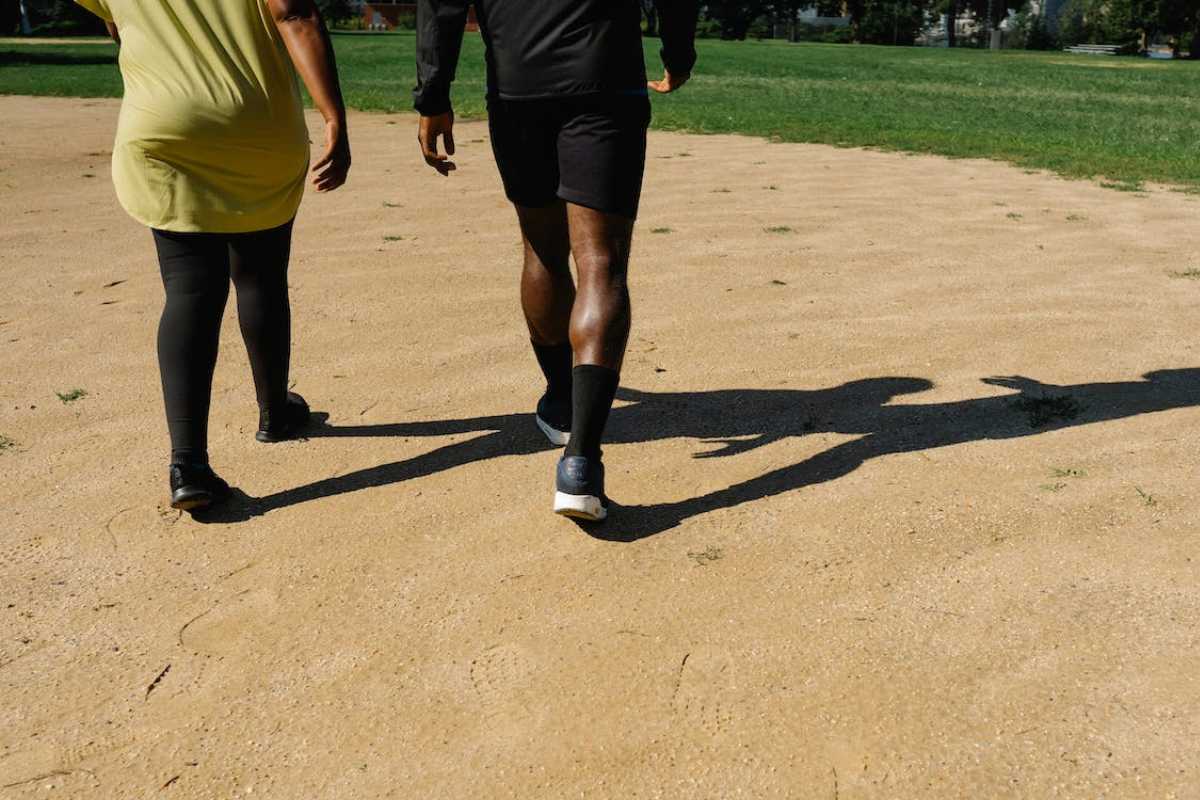The Benefits of Walking 5 Miles a Day: What to Expect
Whether you’re new to physical activity or are a long-time fitness enthusiast, walking 5 miles a day has numerous benefits. It can improve your cardiovascular health, enhance your mood, help achieve and maintain healthy weight, and boost your energy levels.
In this article, we examine the potential benefits of taking 5-mile walks and provide practical information on how best to start a successful daily routine. We’ll cover all the essentials so that you will set yourself up correctly from the beginning. Let’s dive in!
Is Walking 5 Miles a Day Good for Your Body?
Walking 5 miles a day can bring health benefits such as improved cardiovascular health, stress relief, enhanced moods and better sleep cycles. Advantages of walking 5 miles every day also include increased energy levels and reduced risks of developed chronic diseases.

How Far Is 5 Miles?
Five miles is roughly eight kilometers, or about 11000 steps. For runners, it’s almost 8000 steps over the same distance, as running covers more ground per step. Knowing exactly how far you are walking each day is essential in helping to set achievable goals and track progress.
1. Steps in 5 Miles Walking
Walking 5 miles at an average 3mph pace is approximately 11000 steps. The number of steps can also vary depending on your age and gender. Let’s take a closer look at the numbers:
| Activity type | Men steps | Women steps |
|---|---|---|
| Very slow walk (<2mph) | 17184 | 17772 |
| Slow walk (2mph) | 14014 | 14602 |
| Average walk (3mph) | 10844 | 11432 |
| Brisk walk (4mph) | 9259 | 9847 |
The Centers of Disease Control and Prevention recommends 10000 steps daily for adults, which equals about 8 kilometers or 5 miles of walking.
2. Steps in 5 Miles Running
A person with a height of 5 feet 6 inches would take an average of 8100 steps while running 5 miles at a pace of 6mph. The number of steps while running also depends on the speed, stride length, age, and gender.
| Activity type | Men steps | Women steps |
|---|---|---|
| Jog (5mph) | 9176 | 9716 |
| Run (6mph) | 7740 | 8280 |
| Fast run (7.5mph) | 6304 | 6844 |
| Very fast run (10mph) | 4868 | 5408 |
As you can see, the faster you run, the longer your stride length is and the fewer steps you take per mile.
How Often Do You Need to Walk 5 Miles to See Results
Establishing an achievable goal and setting up an effective routine are key to seeing positive results from walking 5 miles a day. With the right approach, this can be managed even with a busy schedule in order to take advantage of all the benefits of this physical activity.
You don’t have to complete all the time in one session. Breaking your daily exercise over several shorter sessions is just as beneficial and allows for more flexibility in fitting an exercise routine into a busy lifestyle.
Walking 5 Miles a Day: Results
Aiming for brisk walks can bring you great results even when walking 5 miles a day for a month. By increasing the heart rate into the moderate-intensity range through regular walking, your body burns more calories.
Combining daily walking and healthy nutrition, you can expect to lose 1-2 pounds every week, depending on your weight. It helps with achieving sustainable weight loss goals as well as reducing abdominal fat.
Our Recommendation for Counting Miles
We recommend the Fitness Tracker with Step Counter for people looking to track their progress. This watch offers accurate tracking of steps, traveled distance, active minutes, burned calories, and sleep health – all in one device! It also has special features such as heart rate, body temperature, and hydration monitoring for more advanced data collection.
Fitness Tracker with Step Counter
The AMOLED HD touch color screen allows you to easily monitor your daily activity with just a glance at your wrist. Enjoy tracking your mileage goals by bringing this essential piece of tech to your everyday journey towards healthier lifestyle and better overall wellbeing!
How Long Does It Take to Walk 5 Miles a Day?
Walking 5 miles a day is a great way to stay in shape, improve heart health, and burn calories. On average, it takes about 1 hour 15 minutes to walk 5 miles at a brisk pace of 4 mph. However, the time can vary depending on age, fitness level, and walking speed.
| Activity type | Average time |
|---|---|
| Very slow walk (<2mph) | 03:20 |
| Slow walk (2mph) | 02:30 |
| Average walk (3mph) | 01:40 |
| Brisk walk (4mph) | 01:15 |
To make sure you’re getting the full benefit for your health, aim for achieving at least 150-300 minutes of moderate exercise per week as recommended by the World Health Organization. A brisk pace should be one that leaves you feeling slightly out of breath without straining too hard.
7 Benefits of Walking 5 Miles a Day
Walking 5 miles a day can bring many physical and mental health benefits. Let’s take a closer look at them:

1. Improved Cardiovascular Health
Walking 5 miles can improve your cardiovascular fitness and increase the heart rate and energy levels in the body. Regular walking helps to keep the heart muscles strong, which is essential for proper functioning of the human body.
It improves overall cardiovascular health and reduces high cholesterol levels in people with low-risk factors for cardiovascular diseases or stroke.
2. Better Mental Health
One of the primary benefits gained from walking 5 miles is stress relief. Regular physical activity can help to reduce cortisol levels in the body — a hormone responsible for the psychological and physiological effects of stress.
This reduction in cortisol leads to feelings of relaxation and joy. Regularly walking five miles a day can boost mood and improve overall wellbeing. Studies have found that those who take regular walks experience improved sleep quality, increased energy levels, better endurance, and lower stress levels.
3. Weight Management
Low-impact exercise like walking helps maintain a healthy weight, as it burns calories while reducing body fat percentage. Regular walking at a pace of 5mph can help you burn many calories: approximately 90-120 calories for every mile while carrying no extra weight.
Therefore, those who take on the challenge of walking five miles a day for weight loss can expect to burn around 500 calories or more. This amount may vary depending on factors such as body weight and terrain. Nevertheless, it is an excellent way to maintain your current body weight and support any desired weight loss.
4. Increased Energy
Walking 5 miles a day is a great way to naturally increase energy levels without relying on artificial stimulants such as caffeine. Walking can significantly speed up the body’s metabolism and allow for more fuel to be used, meaning enhanced physical and mental performance due to increased energy levels.
Regular cardio workouts such as brisk walking can also lead to an increase in muscle power, endurance, and stamina over time. All of these combined benefits will translate into boosted overall energy during the day.
Subscribe to Our Running Newsletter!
Get free running tips from renowned professional athletes and discounts from top-notch brands.
5. Boosted Immune Function
Regular walking has been shown to significantly enhance immune function. Regular walking can improve the body’s response time in recognizing harmful substances and bacteria, leading to a stronger immunity that protects against infection. People who regularly exercise have an increased production of white blood cells, which help protect the body from viruses and diseases.
6. Alleviated Joint Pain
Walking five miles a day is an excellent way of improving joint health and reducing chronic pain associated with arthritis. As walking is considered to be low-impact, it can help reduce the pressure put on the joints.
In addition, mobility allows for better circulation in patients suffering from joint pain due to osteoarthritis or other conditions. When these patients engage in physical activity such as walking, they experience reduced inflammation and swelling in their joints, subsequently helping in alleviation of their symptoms.
7. Reduced Risk of Chronic Diseases
Walking 5 miles a day can reduce your risk of developing certain chronic diseases, such as diabetes and heart disease, due to improved blood pressure levels and reduced cholesterol.
Studies have shown that brisk walking for the recommended 30 minutes per day can improve overall health and make your body stronger.
Can You Lose Weight by Walking 5 Miles a Day?
People often seek effective ways to manage their weight and improve their cardiovascular health. Walking 5 miles a day, even just once a week, can be a game-changer that burns calories and enhances fitness. This activity can burn around 500 calories, contributing to a substantial calorie deficit over time. With a daily commitment to walking 5 miles in addition to healthy eating habits and getting enough sleep, you can work toward achieving your desired weight goals.

Regularly taking a 5-mile walk provides an excellent balance of endurance and cardiovascular training, all while promoting fat loss and maintaining muscle mass.
Here’s a table showing the calorie burn for 5 miles depending on pace and body weight:
| Weight | <2mph | 2mph | 3mph | 4mph |
|---|---|---|---|---|
| 130 lbs | 413 cal | 385 cal | 361 cal | 387 cal |
| 140 lbs | 445 cal | 417 cal | 389 cal | 417 cal |
| 150 lbs | 476 cal | 447 cal | 417 cal | 447 cal |
| 160 lbs | 508 cal | 476 cal | 445 cal | 476 cal |
| 170 lbs | 540 cal | 506 cal | 472 cal | 506 cal |
| 180 lbs | 572 cal | 536 cal | 500 cal | 536 cal |
The table illustrates how calorie loss increases with weight. While a lighter individual will burn fewer calories, they are still reaping the benefits of daily exercise. Consistently walking 5 miles daily can contribute to a caloric deficit, which is essential for weight loss, assuming that dietary intake does not exceed caloric expenditure.
It’s this balance that often leads runners to include walking in their training and recovery programs, as it provides a low-impact way to maintain cardiovascular fitness and manage weight.
Frequently Asked Questions about Walking 5 Miles Every Day
Is Walking 5 Miles a Day Considered Active?
For many people, walking 5 miles a day is considered an active form of exercise. It can be beneficial in helping reduce your waistline and improving overall health. Regular walking can have an immense impact on the body that goes beyond weight loss alone, from reducing stress levels to improving energy levels.
How Do I Train to Walk 5 Miles a Day?
For those who are looking to get in shape through walking, 5 miles a day can be an achievable goal. It is important to start slowly and ease into the program by taking short walks for increasing distances over time.
Is Walking 5 Miles Every Day Too Much?
Answering this question requires assessing a few different factors: current activity levels, fitness goals, and medical conditions. If you have never been particularly active before, 5 miles a day may be too intense. If you have experience in walking, a 5-mile route is good daily training.
Final Thoughts on Walking 5 Miles a Day
Walking 5 miles a day is an excellent way to improve overall health and well-being.
Incorporating the activity into your daily routine can lead to numerous positive health benefits like improved cardiovascular health, stress relief, enhanced mood, weight management and increased energy.
Regular walking has also been linked with alleviated joint pain and reduced risk of chronic diseases such as heart disease or type 2 diabetes. All these benefits make walking 5 miles daily not only easy but incredibly rewarding in terms of physical and mental health.
Making it a habit will take patience and dedication but once you finally form that life-saving habit you can reap all these wonderful rewards for years to come! So grab your favorite tunes, put comfortable shoes on and set off for this wonderful journey!
How many miles a week do you walk? What benefits have you noticed? Please share your experience in the comments below.
Also read:
References:
- “Benefits of Physical Activity,” Centers for Disease Control and Prevention, https://www.cdc.gov/physicalactivity/basics/pa-health/index.htm (accessed December 20, 2023).
- David C. Nieman, Laurel M Wentz, “The Compelling Link between Physical Activity and the Body’s Defense System,” Journal of Sport and Health Science 8, no. 3 https://www.sciencedirect.com/science/article/pii/S2095254618301005 (2019): 201-217, doi: 10.1016/j.jshs.2018.09.009.
- Duck-Chul Lee, Russell R. Pate, Carl J. Lavie, Xuemei Sui, Timothy S. Church, Steven N. Blair, “Leisure-Time Running Reduces All-Cause and Cardiovascular Mortality Risk,” Journal of the American College of Cardiology 64, no. 5 https://www.sciencedirect.com/science/article/pii/S0735109714027466 (2014): 472-481, doi: 10.1016/j.jacc.2014.04.058.
- Freya Oswald, Jennifer Campbell, Chloë Williamson, Justin Richards, Paul Kelly, “A Scoping Review of the Relationship between Running and Mental Health,” International Journal of Environmental Research and Public Health 17, no. 21, https://www.mdpi.com/1660-4601/17/21/8059 (2020): 8059, doi: 10.3390/ijerph17218059.
- “Miles to Steps Calculator,” The Calculator Site, https://www.thecalculatorsite.com/health/miles-steps.php (accessed December 20, 2023).
- “Physical Activity,” World health Organization, https://www.who.int/news-room/fact-sheets/detail/physical-activity (accessed December 20, 2023).
- Wenjing Zhao, Shigekazu Ukawa, Takashi Kawamura, Kenji Wakai, Masahiko Ando, Kazuyo Tsushita, Akiko Tamakoshi, “Health Benefits of Daily Walking on Mortality Among Younger-Elderly Men With or Without Major Critical Diseases in the New Integrated Suburban Seniority Investigation Project: A Prospective Cohort Study,” Journal of Epidemiology 25, no. 10 https://www.ncbi.nlm.nih.gov/pmc/articles/PMC4626390/ (2015): 609-616, doi: 10.2188/jea.JE20140190.
If you have any questions or suggestions, you can contact us via email – [email protected]








I cover 5 miles in about 2 hours. This allows me to walk with pleasure and benefit. So far, I try to walk 5 miles 3 times a week. During the first month, I noticed that my legs started to look better. Now I think it’s time to try to cover this distance faster, or start combining it with jogging.